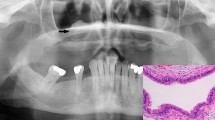Abstract
The Ewing’s sarcoma family of tumors has been reported to originate in a variety of sites, most commonly in the extremities. We herein describe a rare case of primary pulmonary Ewing’s sarcoma in a patient with a family history of sarcoma. The patient was a 42-year-old male, who presented with hemoptysis. Chest radiographs revealed a pulmonary mass in the right lower lobe. Clinical and radiological examinations (computed tomography and positron emission tomography) revealed that the lesion was a primary lesion. The lesion was resected by right lower lobectomy. The tumor was located in the pulmonary parenchyma, and there was no evidence of an extrapulmonary involvement by the tumor. Histologically, the tumor was composed of uniform cells with round nuclei and scant cytoplasm which were arranged in cohesive lobules with rare pseudorosette formation. Immunohistochemically, the tumor cells were positive for CD99, and negative for epithelial markers, neuroendocrine markers, myogenic markers and lymphoma markers. This diagnosis was further supported by the cytogenic and reverse transcriptase-polymerase chain reaction findings of EWS/FLI-1 fusion transcripts. This demonstrated the presence of a very rare primary pulmonary Ewing’s sarcoma. The patient was treated with chemotherapy after the operation because Ewing’s sarcoma is an aggressive neoplasm. The patient has had no recurrent disease for 6 months after the operation.



Similar content being viewed by others
Abbreviations
- ESFT:
-
Ewing’s sarcoma family of tumors
- PNET:
-
Primitive neuroectodermal tumors
- PET:
-
Positron emission tomography
- CT:
-
Computed tomography,
- FDG:
-
8F-fluorodeoxyglucose
- CEA:
-
Carcinoembryonic antigen,
- SCC:
-
Squamous cell carcinoma related antigen
- TBLB:
-
Transbronchial lung biopsy
- RT-PCR:
-
Reverse transcriptase-polymerase chain reaction
- SUV:
-
Standard uptake value
References
Bernstein M, Kovar H, Paulussen M, Randall RL, Schuck A, Teot LA, et al. Ewing’s sarcoma family of tumors: current management. Oncologist. 2006;11:503–11.
Tsuji S, Hisaoka M, Morimitsu Y, Hashimoto H, Jimi A, Watanabe J, et al. Peripheral primitive neuroectodermal tumour of the lung: report of two cases. Histopathology. 1998;33:369–74.
Rud NP, Reiman HM, Pritchard DJ, Frassica FJ, Smithson WA. Extraosseous Ewing’s sarcoma. A study of 42 cases. Cancer. 1989;64:1548–53.
Triche TJ, Askin FB. Neuroblastoma and the differential diagnosis of small-round-, blue-cell tumors. Hum Pathol. 1983;14:569–95.
Dei Tos AP, Wadden C, Calonje E, Sciot R, Pauwels P, Knight JC, et al. Immunohistochemical demonstration of glycoprotein p30/32 MIC (CD99) in synovial sarcoma. A potential cause of diagnostic confusion. Appl. Immunohistochem. 1995;3:168–73.
Fellinger EJ, Garin-Chesa P, Triche TJ, Huvos AG, Retting WJ. Immunohistochemical analysis of Ewing’s sarcoma cell surface antigen p30/32 MIC2. Am J Pathol. 1991;139:317–25.
Lumadue JA, Askin FB, Perlman EJ. MIC2 analysis of small cell carcinoma. Am J Clin Pathol. 1994;102:692–4.
Takahashi D, Nagayama J, Nagatoshi Y, Inagaki J, Nishiyama K, Yokoyama R, et al. Primary Ewing’s sarcoma family tumors of the lung—a case report and review of the literature. Jpn J Clin Oncol. 2007;37:874–7.
Hancom K, Sharma A, Shackcloth M. Case report-thoracic oncologic Primary extraskeletal Ewing’s sarcoma of the lung. Interact Cardiovasc Thorac Surg. 2010;10:803–4.
Raney RB, Asmar L, Newton WA Jr, Bagwell C, Breneman JC, Crist W, et al. Ewing’s sarcoma of soft tissues in childhood: a report from the Intergroup Rhabdomyosarcoma Study, 1972 to 1991. J Clin Oncol. 1997;15:574–82.
Cotterill SJ, Ahrens S, Paulussen M, Jürgens HF, Voûte PA, Gadner H, et al. Prognostic factors in Ewing’s tumor of bone: analysis of 975 patients from the European Intergroup Cooperative Ewing’s Sarcoma Study Group. J Clin Oncol. 2000;18:3108–14.
Zucman J, Melot T, Desmaze C, Ghysdael J, Plougastel B, Peter M, et al. Combinatorial generation of variable fusion protein in the Ewing family of tumours. EMBOJ. 1993;12:4481–7.
Gyorke T, Zajic T, Lange A, Schafer O, Moser E, Mako E, et al. Impact of FDG PET for staging of Ewing sarcoma and primitive neuroectodermal tumours. Nucl Med Commun. 2006;27:17–24.
Arvand A, Denny CT. Biology of EWS/ETS fusions in Ewing’s family tumors. Oncogene. 2001;20:5747–54.
Acknowledgments
We would like to thank Professor Hiroshi Hashimoto and his colleagues in the Department of Pathology, School of Medicine, University of Occupational and Environmental Health for their detailed genetic analysis.
Conflict of interest
Yoshinobu Ichiki and co-authors have no conflict of interest to report.
Author information
Authors and Affiliations
Corresponding author
Rights and permissions
About this article
Cite this article
Ichiki, Y., Nagashima, A., Chikaishi, Y. et al. Primary pulmonary Ewing’s sarcoma: report of a case. Surg Today 42, 812–815 (2012). https://doi.org/10.1007/s00595-012-0170-4
Received:
Accepted:
Published:
Issue Date:
DOI: https://doi.org/10.1007/s00595-012-0170-4




